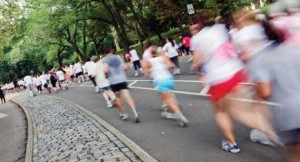Expert Tip: Hitting Your Stride
This blog was contributed by Jaime Lynch, DPT, clinical coordinator at Bon Secours In Motion Physical Therapy at Ghent Station. 
Have you ever wondered, “What do I really look like when I am running?” or “what does it mean to have good running form?” Many factors come into play when you have good running from. From the tip of your head to the point of your toes, you could read for days on how to become the perfect runner.
Today lets zone in on the body part most people consider when running: your legs. Stride length is defined as “the distance between two successive placements of the same foot.” Having good stride technique can increase speed, decrease risk of injury, and provide for an overall better running experience. Here are a few tips to keep in mind while pounding the pavement:
- While running, concentrate on landing your foot underneath you. “Over striding,” or taking excessively long strides, may be your first instinct to increase speed, but increasing stride length requires more energy, increased hip mobility and higher levels of gluteal activation. This can lead to hip and knee injuries. To avoid injury, focus on increasing the number of strides you take (stride frequency) instead.
- For endurance running, only a slight knee lift is necessary while bringing your leg forward. Exaggerated knee lift is reserved for sprinting.
- Muscular strength is necessary for a good solid stride. Nearly every muscle of your leg is activated at some point during the running cycle. An often neglected group of muscles that are important in the stability and power of running are the gluteal and hip rotators. Don’t skimp out on your strength training days.
- Just as strength is important, so is flexibility. Muscles work at an optimal length tension ratio. If a muscle is too short, i.e. not flexible enough, they will not function properly to provide the optimal stride. Your hamstring flexibility is most directly related to stride length. Stay limber.
What is most important to remember is to do what feels good and right. Pain is the body’s best indicator that something is not correct. So listen to your body and keep putting one foot in front of the other to becoming a better runner.

